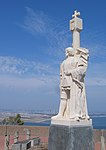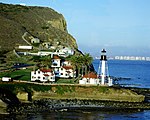Ballast Point Whaling Station

Ballast Point Whaling Station in San Diego, California in San Diego County, is a California Historical Landmark No. 50 listed on December 6, 1935. The Ballast Point Whaling Station was built in 1858 by Captain Miles A. Johnson his cousins, Henry and James A. Johnson and the twin Packard brothers, Alpheus and William, brothers. The Portuguese-American Johnsons, Alpheus and William came to San Diego from Massachusetts in 1856. The Ballast Point Whaling Station was on Ballast Point. The Whaling station processed whales to make whale oil. Whale oil was a very popular as in oil lamps it produced little smoke. Whale oil was also used in miner's headlamps, lighthouses, soaps, and candles, and as machinery lubricant. In 1869 the United States acquired the site for a quarantine station and built a lighthouse and later Fort Rosecrans, named after Major General William Rosecrans. Whaling operations at Ballast Point stopped in 1873. In 1946 the site became a United States Submarine Base. The site today is Naval Base Point Loma founded in 1959. A Ballast Point Whaling Station historic marker is located on the Navy Base. Before Ballast Point Whaling Station the site was the Spanish Fort GuijarrosCalifornia gray whales were hunted for the Ballast Point Whaling Station. Captain Packard and his brother hunted whales for four years off the California Coast. Portuguese, Africans, Irish, Spaniards, Mexicans and Englishmen all hunted whales on the California Coast. There was a second major whaling station at La Playa. Gray whales swam between warm breeding grounds off Mexico and the rich feeding grounds off Alaska and Arctics. Gray whales were hunted on this route. San Diego whaling ended in the 1880s as petroleum oil was now less costly and the whale population has drop vastly. Gray whales, humpback whales, blue whales, and right whales are now a protected species.
Excerpt from the Wikipedia article Ballast Point Whaling Station (License: CC BY-SA 3.0, Authors, Images).Ballast Point Whaling Station
Fort Rosecrans Boulevard, San Diego
Geographical coordinates (GPS) Address Nearby Places Show on map
Geographical coordinates (GPS)
| Latitude | Longitude |
|---|---|
| N 32.683 ° | E -117.236 ° |
Address
Fort Rosecrans Boulevard
Fort Rosecrans Boulevard
92147 San Diego
California, United States
Open on Google Maps










